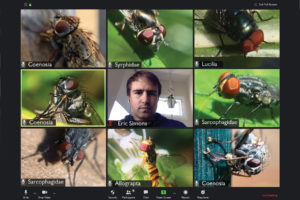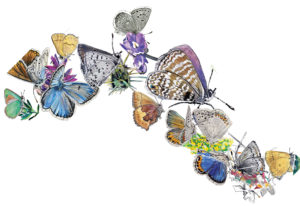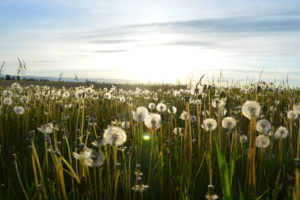He was already there when the first members of the staff arrived for work at 8 a.m. on the morning of the Regional Parks Botanic Garden’s annual native plant sale. Sitting on the ground outside the front gate, bundled in a big down jacket and sipping a large cup of steaming coffee against the morning chill, this otherwise normal-seeming man was waiting out the two hours before the sale opened. Within 60 minutes, he was joined by more than 100 others, but his place at the front of the line was secure. Why would anyone in his or her right mind get up early on a Saturday morning and spend two frigid hours waiting for a plant sale to open?
The answer lies in the legendary passions of gardeners. During the height of “tulip mania” in the 1630s, demand for tulip bulbs inflated the price of one rare bulb to the equivalent of 12 acres of land. Later, 19th century “orchidelirium” sent collectors to almost every unexplored corner of the earth in search of new varieties for their wealthy garden enthusiast patrons in Europe. California native plant gardeners are no less passionate (although perhaps more practical), and will wait in line for an hour or more for the opportunity to buy plants, partly because many prized native plants are still not widely available in the nursery trade. In the case of the chilled but intrepid early-arriving plant sale patron, the enticement was the opportunity to purchase trilliums, beautiful flowers almost never seen in commercial nurseries.
At the intersection of commerce and conservation, native plant sales are win-win propositions for both the gardeners who patronize them and the nonprofit organizations that hold them. This year’s are coming right up in April and May (check out our lists of spring sales and tours).
For nonprofits focused on native plant conservation or education, plant sales are reliable fundraisers, and they’re an excellent way to introduce new people to the world of native plants. Many of the sales have become institutions around the Bay Area.
These very “green” institutions were probably born in 1966, in response to a financial crisis for the fledgling California Native Plant Society (CNPS). In her oral history, CNPS founding member Jenny Fleming recounted the impetus for the first sale:
[In 1966, we] had opened an office down on University Avenue [in Berkeley], hired a part-time secretary, and we simply did not have the money to do this….We were in debt with no knowledge of how to get out of debt. There was a very serious meeting to decide what to do, and the idea came up that we could have a plant sale. There were, to my knowledge, no organizational plant sales in the Bay Area then. I think we were the originator of that idea in this area….Ours was an idea out of desperation but one that appealed to everyone because it was the sort of thing we should be doing. Plant sales have a very strong educational value. We could get the plants out to people who wanted them when very few nurseries carried any natives.
Over the years, CNPS grew to a statewide organization with seven chapters in the Bay Area, most of which now hold annual or biannual native plant sales. A number of other nonprofits that focus on plant conservation and education also hold plant sales, including several public gardens.
Another win-win aspect of nonprofit plant sales is their prices, which are usually lower than those of commercial nurseries. Although average prices are significantly higher than the $1 per gallon-sized plant charged by CNPS in 1966, the sales still offer great value to beginners experimenting with growing natives as well as professional landscapers looking for plants they can’t find elsewhere. Yet even with low prices, native plant sales held by nonprofit organizations around the Bay Area produce important income. Some of the smaller sales raise a few thousand much-needed dollars, while the most lucrative once-a-year plant sale grosses over $100,000 for Cabrillo College in Aptos.
Part of the reason these sales are such successful fundraisers is the low cost of producing the plants, thanks to volunteer labor. The California Native Plant Society sales are 100 percent volunteer-run. Even public gardens rely largely on volunteers for their plant sales, with paid staff usually in supervisory or advisory roles. And these volunteers don’t just show up to sell plants one day each year. Most make a weekly or perhaps monthly commitment of a few hours devoted to propagating and caring for the plants, often growing them from seed and raising them to saleable size over one or two years. The fun of a social and maybe even therapeutic activity combined with the opportunity to gain first-hand knowledge of growing plants draws people in. Over the course of a year, dozens to more than 100 volunteers contribute their time to each sale. At the Regional Parks Botanic Garden in Berkeley, volunteers supported the plant sale with over 2200 person-hours in 2008, equivalent to more hours than a full-time employee would work in a year.
Completing the circle of giving, the plant sales support programs and activities that benefit their larger communities. Without exception, the organizations holding native plant sales use the funds they raise to further their missions of education and/or conservation. CNPS chapters use the proceeds of plant sales to fund wildland conservation, ecosystem restoration, and public lecture/field trip programs focusing on native plants. Public gardens like the UC Berkeley Botanical Garden, San Francisco Botanical Garden, and Regional Parks Botanic Garden use the funds raised by their plant sales for conservation and public education programs as well as garden improvements that ultimately benefit everyone who visits the garden.
The many native plant sales in the Bay Area are usually held in spring or fall. While fall sales make it easy for gardeners to put their new plants in the ground at the most favorable time of year, spring sales show off many plants in their full flowering glory, as do the free native plant garden tours offered in the Bay Area each spring.
Spring Native Plant Sales
CNPS Santa Clara Valley Chapter
April 4, 2009, 10 a.m. – 3 p.m.
Hidden Villa Ranch, 26870 Moody Road, Los Altos Hills
http://goingnativegardentour.org/pressroom/2009SpringSalePressRelease.pdf
All natives
California Horticultural Society Specialty Plant Sale and Gala Fundraiser
April 4, 2009, 5 – 8 p.m.
Lakeside Park Garden Center, 666 Bellevue Avenue, Oakland
$5 for members, $20 for nonmembers
http://www.calhortsociety.org/
Good selection of natives
Regional Parks Botanic Garden
April 18, 2009, 10 a.m. – 3 p.m.
Wildcat Canyon Road at S. Park Drive in Tilden Regional Park, Berkeley
http://www.nativeplants.org
All natives
Gardens at Heather Farm
April 18, 2009, 9 a.m. – 12 p.m.
600 North San Carlos Drive, Walnut Creek
http://www.gardenshf.org/PlantSale.html
A selection of natives
UC Botanical Garden at Berkeley
April 25, 2009, 9 a.m. – 2 p.m.
200 Centennial Drive, Berkeley
http://botanicalgarden.berkeley.edu/
Large selection of natives
CNPS Willis Linn Jepson Chapter (Solano County)
May 2, 2009, 9 a.m. – 3 p.m.
Benicia Community Garden, Military East and East Second Street, Benicia
http://cnpsjepsonchapter.homestead.com/2009_Spring_Plant_Sale.pdf
All natives
San Francisco Botanical Garden
May 2, 2009, 10 a.m. – 2 p.m.
1199 Ninth Avenue at Lincoln Way, San Francisco
http://www.sfbotanicalgarden.org/
Large selection of natives
Cabrillo College
May 9, 2009, 9 a.m. – 5 p.m., and May 10, 10 a.m. – 2 p.m.
Environmental Horticulture Center and Botanic Gardens
6500 Soquel Drive, Aptos
http://www.cabrillo.edu/academics/horticulture/plant_sale/plantsale.html
Good selection of natives
Native Garden Tours
Native Plant Garden Tour, CNPS Yerba Buena Chapter
April 5, 2009, 11 a.m. – 3 p.m.
http://www.cnps-yerbabuena.org/gardens/annual_garden_tour.html
San Francisco and northern San Mateo counties
Going Native Garden Tour, CNPS Santa Clara Valley Chapter
April 19, 2009, 10 a.m. – 4 p.m.
http://goingnativegardentour.org/
Santa Clara Valley and San Francisco Peninsula
Bay-Friendly Garden Tour (not limited to native plants)
April 26, 2009, 10 a.m. – 4 p.m.
http://www.stopwaste.org/home/index.asp?page=617
Alameda County
Bringing Back the Natives Garden Tour
Sunday, May 3, 2009, 10 a.m. – 5 p.m.
http://www.bringingbackthenatives.net/
Alameda and Contra Costa counties

.jpg)



